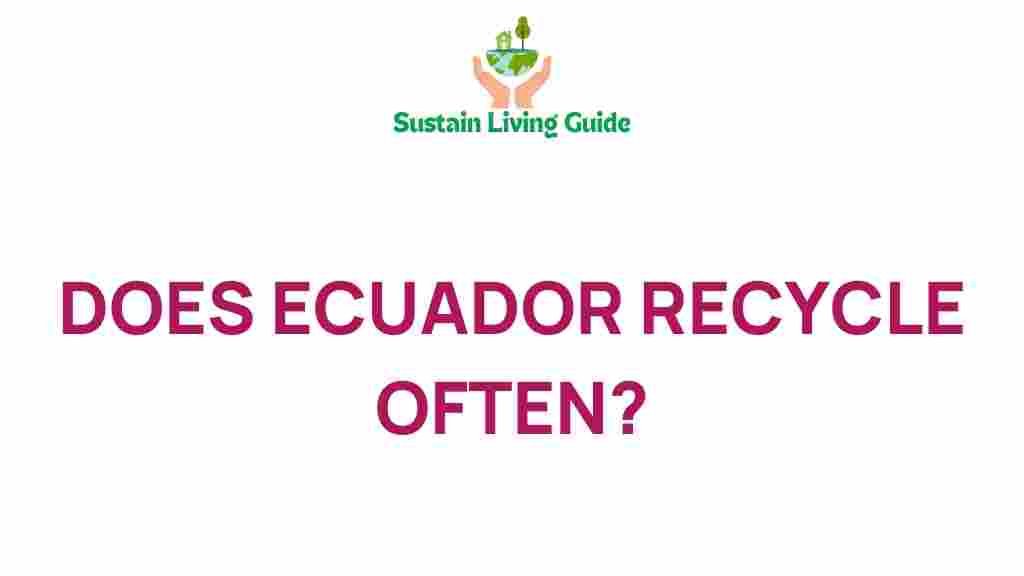Ecuador Recycling: An Overview
Ecuador, a country known for its rich biodiversity and stunning landscapes, is also facing significant challenges related to waste management and recycling. With increasing urbanization and population growth, the pressure on Ecuador’s waste management system has intensified. This article delves into Ecuador’s recycling practices, examining their effectiveness, challenges, and potential solutions for a more sustainable future.
The Current State of Recycling in Ecuador
Recycling in Ecuador is still in its infancy compared to many developed nations. However, the government and various organizations are making strides to improve these practices. Here are some key points regarding the current recycling landscape:
- Waste Generation: Ecuador generates approximately 7.2 million tons of waste annually, with only a small percentage being recycled.
- Recycling Rates: According to recent statistics, the national recycling rate hovers around 15%, which is relatively low.
- Government Initiatives: The Ecuadorian government has implemented policies aimed at promoting recycling, including the “Waste Management Law” enacted in 2018.
Types of Recyclable Materials
In Ecuador, various materials can be recycled, including:
- Plastics: Most types of plastic are recyclable, although the infrastructure for sorting and processing is limited.
- Paper and Cardboard: These materials have a higher recycling rate, thanks to established collection systems.
- Metals: Aluminum and steel are commonly recycled, especially from beverage containers.
- Glass: Glass recycling is less common but is gaining traction in urban areas.
Challenges Facing Ecuador’s Recycling Practices
Despite the existing frameworks, several challenges hinder the effectiveness of Ecuador’s recycling practices:
Lack of Awareness and Education
Many Ecuadorians are unaware of proper recycling practices or the importance of recycling. Educational campaigns are needed to raise awareness about the benefits of recycling and how to do it correctly.
Inadequate Infrastructure
The infrastructure for collecting and processing recyclables remains underdeveloped. Many areas lack the necessary bins for sorting waste, leading to contamination of recyclable materials.
Economic Constraints
The economic situation in Ecuador poses another challenge. Many recycling programs rely on funding, and limited financial resources can impact their effectiveness and reach.
Step-by-Step Process of Recycling in Ecuador
Understanding the recycling process in Ecuador can help individuals and communities contribute more effectively. Here’s a step-by-step guide:
1. Separation of Waste
Citizens are encouraged to separate their waste at home into different categories:
- Recyclables: Plastics, glass, metals, paper, and cardboard.
- Organic Waste: Food scraps and garden waste.
- General Waste: Non-recyclable materials.
2. Collection
Local governments typically provide collection services for waste, including designated recycling days. It is essential to check local regulations regarding collection schedules.
3. Processing
Once collected, recyclable materials are sent to processing facilities. Here, they are sorted, cleaned, and prepared for recycling into new products.
4. Re-manufacturing
Recycled materials are then sent to manufacturers to create new products, contributing to a circular economy.
Troubleshooting Common Recycling Issues in Ecuador
Recycling can be complicated, and individuals may face challenges when attempting to recycle correctly. Here are some common issues and troubleshooting tips:
Issue 1: Contaminated Recyclables
Problem: Contaminated recyclables can lead to entire batches of materials being sent to landfills.
Solution: Rinse out containers and remove food residues before placing them in the recycling bin.
Issue 2: Lack of Local Recycling Facilities
Problem: In rural areas, access to recycling facilities may be limited.
Solution: Engage with your local government to advocate for better recycling facilities and services.
Issue 3: Confusion Over What Can Be Recycled
Problem: Many people are unsure what materials are recyclable.
Solution: Familiarize yourself with local recycling guidelines or check resources like Ecuador’s Ministry of Environment for comprehensive lists.
Innovative Recycling Initiatives in Ecuador
In recent years, various innovative initiatives have emerged to enhance recycling efforts in Ecuador. Here are some noteworthy examples:
Community-Based Recycling Programs
Many communities are establishing grassroots recycling programs that encourage local participation. These initiatives often include:
- Community clean-up days.
- Workshops on proper recycling techniques.
- Incentive programs for households that actively participate in recycling.
Partnerships with NGOs
Numerous non-governmental organizations (NGOs) are partnering with local governments to promote recycling awareness and education. These partnerships focus on:
- Community engagement campaigns.
- Workshops for schools to educate children about recycling.
- Research on effective recycling strategies tailored to local needs.
Technological Advancements
Technology plays a vital role in improving recycling in Ecuador. Innovations include:
- Mobile Apps: Apps that help residents locate recycling centers and track their recycling habits.
- Smart Bins: Bins equipped with sensors that notify collectors when they are full.
Conclusion: The Path Forward for Ecuador’s Recycling Practices
While Ecuador’s recycling practices face several challenges, there is a growing awareness and commitment to improving the situation. By enhancing education, investing in infrastructure, and fostering community involvement, Ecuador can make significant strides in its recycling efforts. As individuals, we play a crucial role in this movement by adopting responsible recycling habits and advocating for better systems.
In conclusion, while Ecuador recycling is still developing, the potential for improvement is immense. With collective effort and commitment to sustainable practices, the nation can pave the way for a greener future.
For more information on recycling initiatives in Ecuador, refer to this detailed study.
This article is in the category Waste and created by SustainLivingGuide Team
